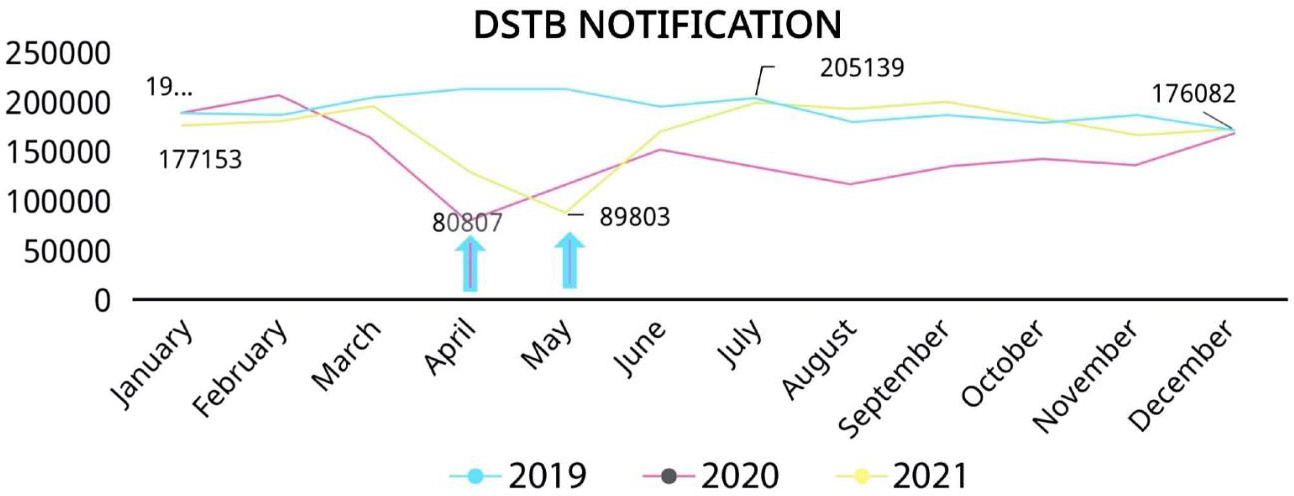Translate this page into:
NIKSHAY: Challenges during COVID pandemic and way forward
CORRESPONDING AUTHOR: Dr Rekha Palani, Senior resident, Department of Community Medicine, Bhaarath Medical College and Hospital, Bhaarath Institute of Higher Education and Research, Selaiyur, Chennai. Tamil Nadu. India - 600073 E Mail ID: dr.rekhajkn@gmail.com
-
Received: ,
Accepted: ,
CITATION: Palani R, Vidya DC, Arunadevi K. NIKSHAY: Challenges during COVID pandemic and way forward. J Comp Health. 2022;10(2):92-93. Doi: https://doi.org/10.53553/JCH.v10i02.008
Abstract
NIKSHAY provides the data regarding the total number of registered cases, treatment provided and their adherence tracking in both public and private sectors. The astounding impact of COVID is the decline in notification of tuberculosis cases. The situation was worsened by the changes in health seeking behaviour of the patients, diversion of resources all over the country. Bidirectional screening for TB- COVID, doorstep delivery of services, enhanced active and passive case-finding efforts were implemented to improve this massive deterioration.
Dear Editor,
The Pandemic which has turned the life of everyone in the world since 2020, has not only the direct impact on emerging COVID-19 cases and death, but also disrupted the health care provision of other dangerous diseases like Tuberculosis (TB) and Human Immunodeficiency Virus (HIV). Intensive measures have been taken by National Tuberculosis Elimination Programme (NTEP) for improving the early diagnosis and treatment of tuberculosis patients through a web enabled patient management system called NIKSHAY. It provides the data regarding the total number of registered cases, treatment provided and their adherence tracking in both public and private sectors in India which are the key features of END TB strategy.
The astounding impact of COVID is the notification of tuberculosis cases which was drastically reduced to less than a half, especially during the first wave. This was due to a major rise in COVID cases and subsequent lockdown worldwide in 2020, as evident by the lowest number of TB cases in April 2020 reported ever in the last three years. Similarly conspicuous decline in the notification of Tuberculosis cases was observed during the second wave of COVID as-well. Hence forth there was a delay in diagnosis of TB and initiation of TB treatment. One of the reason for subsequent reduction in the spread of TB cases was because, people followed strict respiratory etiquette and social distancing.
As there is a pivotal connection between COVID-19 and Tuberculosis, showing similar symptoms like cough, difficulty in breathing, fever and almost similar mode of transmission, affecting Respiratory System. The situation was worsened by the changes in health seeking behaviour of the patients with chest symptoms, diversion of the human and material resources (healthcare) across the country, making it onerous in identifying the new tuberculosis cases.
However the notification rates were still at the lower range even in the post lockdown period. A study done by Golandaj J4 shows that there was 55.8% reduction in TB case notification during lockdown and 37% reduction during post lockdown compared to previous year. NTEP has been retrieving the missing TB patients by introducing bidirectional screening for TB-Covid, doorstep collection of samples and delivery of services as well as the behaviour change of people in terms of respiratory etiquette and social distancing, which in the long run is expected to have an impact on reducing the transmission of TB as well as other respiratory infections within the community.

- MONTHLY NOTIFICATION OF CASES REPORTED IN NIKHAY FOR THE YEAR 2019, 2020, 20211
Measures to ameliorate the notification of tuberculosis cases are taken by NTEP through intensive community engagement, maintaining awareness of the importance of TB services. The enhanced active and passive case-finding efforts, including rapid scaling up of contact tracing of all notified cases will help us in augmenting the notification rates and achieve the target by 2025. Involvement of digital technology and accelerating surveillance of vulnerable groups and identification of high risk groups will prevent the unseen upcoming epidemic of Tuberculosis.
REFERENCES
- M. India TB annual Report 2022 :: Central TB Division [Internet]. Tbcindia.gov.in. 2022. Available from: https://tbcindia.gov.in/index1 .php?lang=1&level=1 &su blinkid=5613&lid=3658 (accessed )
- [Google Scholar]
- Impact of COVID-19 pandemic on tuberculosis care in India. Clinical Microbiology and Infection. 2021;27(2):293-294.
- [CrossRef] [PubMed] [Google Scholar]
- Effect of COVID-19 pandemic on tuberculosis notification. Indian Journal of Tuberculosis. 2022;69(3):364-365.
- [CrossRef] [PubMed] [Google Scholar]
- Insight into the COVID-19 led slow-down in TB notifications in India. Indian Journal of Tuberculosis. 2021;68(1):142-145.
- [CrossRef] [PubMed] [Google Scholar]
- TB control in India in the COVID era. Indian Journal of Tuberculosis. 2021;68(1):128-133.
- [CrossRef] [PubMed] [Google Scholar]





